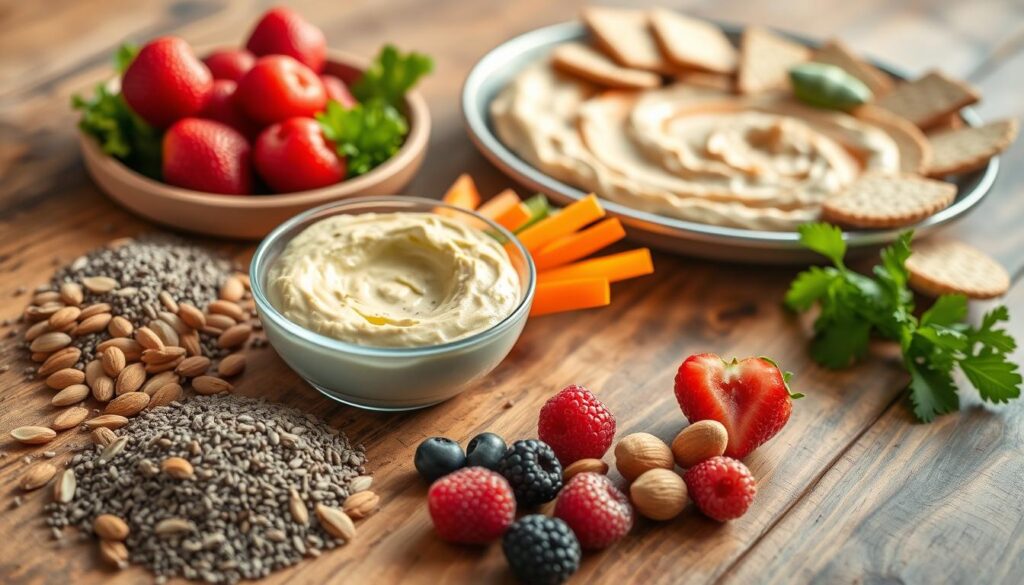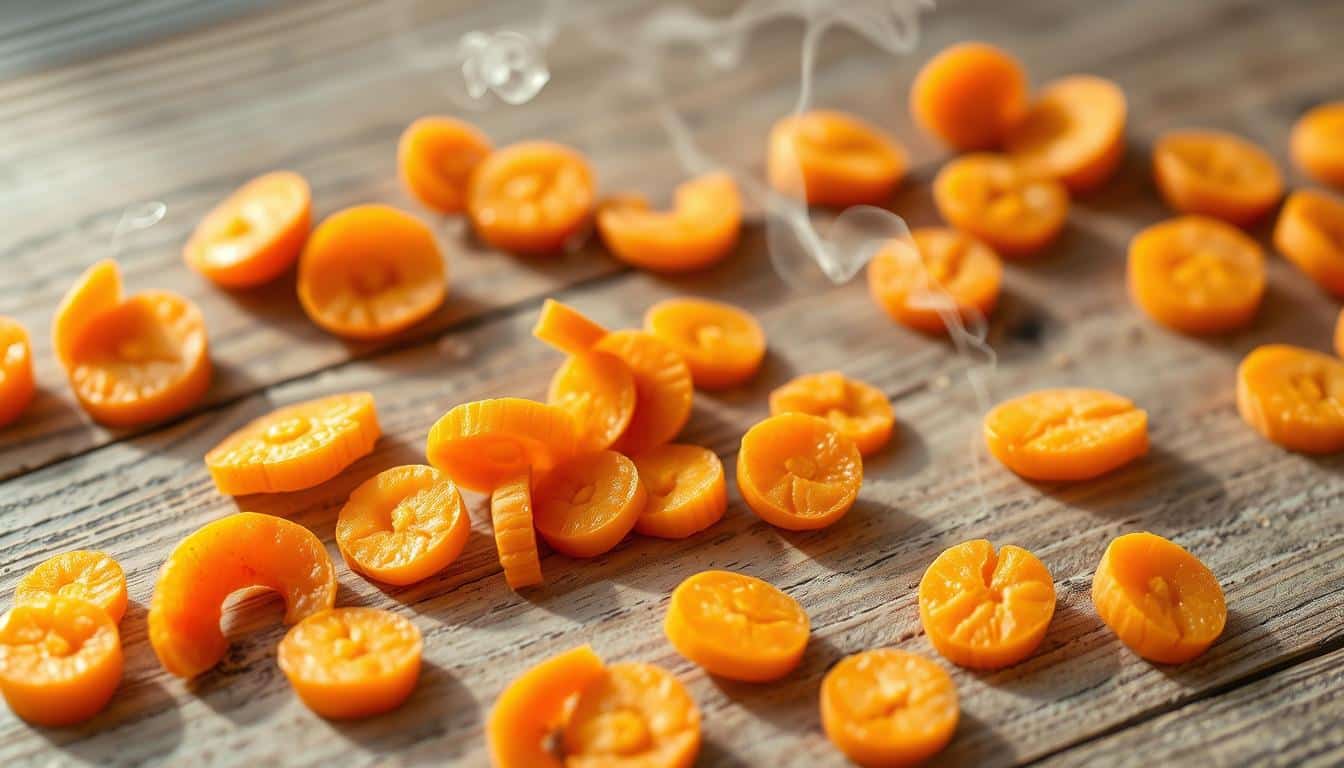About 58.5 million people in the U.S. have arthritis. Many want ways to lessen their pain without always using drugs. Drugs like NSAIDs can hurt the liver and kidneys. So, eating the right foods can help as part of your health care. Maxine Smith, RD, LD, says eating healthy snacks can lessen arthritis symptoms. This fits with other treatments like working out and physical therapy.
Some snacks can help your joints. They have omega-3s, vitamins, and minerals that fight inflammation. They also help your cartilage and bones. Eating snacks like walnuts, salmon, berries, and drinking green tea can be good for your joints. These snacks give you joint-helping nutrients when you’re hungry between meals.
There’s no diet that can cure arthritis, but some snacks can make it better. Eating snacks that fight inflammation can help you have fewer bad days and move better. If you still hurt after changing what you eat, talk to a doctor or a dietitian. They can help make a plan that’s right for you and check if some foods make your arthritis worse.
Why Snacks Matter for Joint Health and Inflammation
What you eat between meals affects your body’s reaction to stress and injury. Inflammation is how your immune system reacts to harm. While short-term inflammation aids healing, ongoing inflammation from arthritis continues to activate immune responses. This can cause pain and damage your joints over time.
Eating foods high in omega‑3s, polyphenols, and phytochemicals can help lower inflammation. Anti‑inflammatory snacks might lessen markers like C‑reactive protein. This can make symptoms better for many folks.
When you snack can impact inflammation too. Nutrients in your blood affect how your body handles inflammation and repairs itself daily. Eating protein, healthy fats, and antioxidants throughout the day helps. It ensures a constant supply of helpful nutrients, reducing inflammation peaks and aiding movement.
Studies suggest that changing what you eat can decrease inflammation and symptoms. But diet and NSAIDs serve different purposes. NSAIDs give quick relief for pain and swelling, whereas diet has a slower, wider effect. Choosing anti‑inflammatory snacks could mean you’ll need fewer NSAIDs.
Changing your diet is part of the solution. If eating better and timing your snacks doesn’t help your symptoms, get medical advice. A correct diagnosis can guide you towards the right treatment. This might include medicine, physical therapy, or seeing a specialist for your chronic inflammation arthritis.
Functional snacks for joint-health support
Snacks aimed at joint health can soothe inflammation and shield cartilage. Look for snacks that blend omega-3s, polyphenols, and vitamins to bolster bones. These choices help lessen oxidative stress and aid in keeping you moving smoothly.
Overview of targeted nutrients found in snacks
Snacks high in omega-3 include foods like canned salmon, sardines, and walnuts, along with chia and flax seeds. These fats cut down on cytokine activity, which leads to joint pain.
Snacks packed with polyphenols, such as berries, dark chocolate, and green tea, are rich in antioxidants. Compounds like anthocyanins and EGCG in these snacks work against oxidative harm.
Snacks that are good for your joints also have lots of vitamins. They should give you vitamin D, C, K, B vitamins, calcium, magnesium, and zinc. These nutrients help fix bone and cartilage.
Snack formats that deliver benefits: whole foods, fortified bites, and beverages
Whole-food snacks are straightforward and dependable. For instance, try a 1-ounce serving of nuts, ½–1 cup of yogurt, or ¼–½ cup of canned salmon with some whole-grain crackers.
If you’re looking for convenience, fortified bites and energy bars can be good options. They can provide extra omega-3s or curcumin. Just remember to check the labels and consult your doctor about any supplements.
Drinks like brewed green tea or matcha are great polyphenol-packed options. They go well with a small plate of nuts and fruit for a well-rounded snack.
Practical portion and frequency guidance for joint-supporting snacks
Try to have 1–2 snacks a day that support joint health. Common amounts include 1 ounce of mixed nuts, ½–1 cup of plain yogurt, or 2 tablespoons of chia seeds in a pudding.
To get enough omega-3s, eat fish-based snacks throughout the week. Small, regular amounts keep inflammation down without adding too many calories.
Stick to whole-food snacks as your go-to choice. Use fortified snacks or drinks when you need something fast. Eating these kinds of snacks regularly helps you hit your goals for omega-3s, polyphenols, and vitamins.
Top anti-inflammatory snack ingredients and why they work
Many ingredients offer real perks for easing joint pain and lowering inflammation. Opt for whole foods, blending healthy fats, plant elements, spices, and active cultures. Here’s a rundown of top picks and their actions in the body.
-
Omega-3 sources — Walnuts, chia, flaxseed, canned salmon, sardines.
Salmon, mackerel, and anchovies are rich in EPA and DHA, cutting down inflammation signals. Walnuts and flaxseed provide ALA, helping in similar ways. Try mixing walnuts or chia with canned salmon for a snack rich in omega-3.
-
Polyphenol-rich choices — Berries, dark chocolate, green tea.
Berries pack anthocyanins while dark chocolate offers flavanols, both easing joint stress. Green tea’s EGCG promotes muscle and joint well-being. Eating these snacks in small amounts during the day boosts antioxidant levels and fights inflammation.
-
Spices and botanicals — Turmeric (curcumin), ginger, black pepper for absorption.
Curcumin in turmeric cuts inflammatory markers but needs help to be absorbed well. Mix it with black pepper or healthy fats to improve its benefits. Ginger, when heated, turns into shogaols boosting anti-inflammatory effects. Turmeric-ginger bites are a flavorful way to enjoy these benefits while snacking.
-
Probiotic and gut-supporting foods — Yogurt, kefir, fermented snacks.
Yogurt and kefir’s live cultures maintain gut balance, affecting overall inflammation. Adding fermented pickles or miso enriches your diet. Probiotic snacks are great for digestion and immune health, assisting joints too.
-
Other supportive choices — Extra virgin olive oil, cherries, broccoli, low-fat dairy, soy.
Olive oil offers oleocanthal, mimicking mild NSAIDs. Cherries and broccoli bring anthocyanins and sulforaphane, aiding in pain reduction and cartilage health. Low-fat dairy and fish provide bone-strengthening calcium and vitamin D. Adding nuts delivers vitamin E and magnesium, covering overall nutrient needs.
Make simple snacks like berry-walnut combos, chia pudding with olive oil, yogurt mixed with green tea powder, or whole-grain crackers with canned sardines. Smart pairings improve nutrient uptake, helping you meet anti-inflammatory goals daily.
Seven snack ideas that support joints and mobility
Snacks should be easy and full of nutrients to reduce inflammation and support mobility. We have mixed omega-3s, polyphenols, calcium, and probiotics into some great snacks. You can easily make these snacks at home or take them with you.

-
Walnut and berry chia pudding with calcium-rich milk
For a walnut chia pudding, mix berries and orange with milk high in calcium or plant-based options. Then, add walnuts for more nutrients. It’s creamy and perfect for taking with you as a joint-friendly snack.
-
Greek yogurt parfait with citrus and ground flaxseed
Add ½ to 1 cup of plain Greek yogurt in layers with orange pieces, berries, and flaxseed. Choose yogurts with active cultures. This parfait is rich in probiotics, calcium, and omega-3s, all packed into one serving.
-
Salmon or sardine whole-grain crackers with olive oil and herbs
Put canned salmon or sardines on whole-grain crackers. Add some olive oil, pepper, and dill on top. Salmon snacks are good for inflammation and provide important nutrients.
-
Veggie sticks with bean or lentil dip
Use carrots, cucumbers, and peppers with hummus or bean dip. Add lemon and ginger for a tasty kick. This snack offers lots of nutrients, especially if you add broccoli or cauliflower.
-
Turmeric-ginger energy bites with dates and oats
Mix dates, oats, walnuts, ginger, turmeric, and pepper. Chill the mix into small bites. These bites help absorption of turmeric and are great for energy and reducing inflammation.
-
Dark chocolate and mixed nut snack packs
Mix a piece of dark chocolate with almonds, walnuts, and some dried berries. This snack offers benefits without too much sugar.
-
Matcha or green tea with a small fruit-and-nut plate
Enjoy matcha or green tea with apples, walnuts, and almonds. Tea and nuts provide fats and antioxidants for a light, beneficial snack.
Stick to the right amounts for full benefits: around 1 ounce of nuts, ½–1 cup of dairy or similar drinks, and 3–4 ounces of canned fish weekly. Change up these snacks to keep your joints happy every day.
Snacks to avoid for better joint outcomes
What you eat for snacks can either make joint pain worse or better. Avoid snacks with lots of added sugars and refined grains. Foods such as white crackers, candy, sweetened granola bars, and packaged pastries can increase inflammation.
Aim to limit added sugar to under six teaspoons daily for women and nine for men.
Be mindful of the fats in processed snacks. Items like chips and baked goods often contain oils high in omega-6. This can lead to worse joint inflammation.
Trans fats and snacks high in saturated fat also pose risks. This includes certain fast-food items and fatty deli meats.
Always check food labels for sugar and fat content before purchasing. Look for terms like partially hydrogenated to find trans fats. Examine the nutrition facts for added sugars and fat. Then, see which oils are listed in the ingredients.
- Highly processed, sugary snacks: candy, frosted pastries, sweetened cereals.
- Refined-grain snacks: white crackers, plain chips, instant flavored rice cakes.
- Omega-6 and trans fat heavy options: many packaged chips, microwave popcorn with hydrogenated oils, some commercial cookies and snack cakes.
Hidden salt in snacks can also harm joints by causing fluid retention and increasing blood pressure. Many packaged snacks are high in both sodium and inflammatory ingredients, making them doubly harmful.
Opt for snacks made with healthier oils like extra virgin olive oil, avocado oil, or natural nut butters. These better options can reduce inflammation and are good for your joints.
Reducing smoking and heavy drinking can also help lower inflammation. Cutting back on alcohol and stopping tobacco can support dietary improvements, easing the strain on your joints.
How to build a Mediterranean-style snack plan for joint health
A Mediterranean snack plan is about simple, whole foods. These foods lower inflammation and make your joints feel better. Small, consistent snacks pack nutrients like omega-3s and fiber. With easy swaps, you can make these snacks a part of your everyday life.
Core Mediterranean snack patterns that reduce inflammation
Pick nuts, seeds, and fruits for snacks that are easy to take with you. Add yogurt with live cultures and chopped fruits for calcium and probiotics. Try veggie sticks with hummus or white-bean dip for fiber and protein. Canned salmon on crackers gives you omega-3 fats on the go.
Swapping high-inflammatory snacks for Mediterranean alternatives
Trade chips and cookies for nuts and berries to avoid added sugar. Swap soda for green tea or water. Choose crackers with olive-oil tapenade instead of spreads high in omega-6 fats. These swaps are good for you and help reduce inflammation.
Sample one-week snack rotation for sustained joint support
Plan a variety of plant and seafood snacks for the week. Try to eat fish twice and have plant-based, anti-inflammatory foods every day.
- Day 1: Walnuts with mixed berries
- Day 2: Greek yogurt parfait with flaxseed and orange slices
- Day 3: Veggie sticks with hummus
- Day 4: Chia pudding with milk and chopped almonds
- Day 5: Canned salmon on whole-grain crackers, olive oil on top
- Day 6: Energy bites with turmeric-ginger and green tea
- Day 7: Dark chocolate (70% cocoa) and nuts
Change the snacks as the seasons change. Maybe use citrus instead of berries or swap walnuts for pistachios. You can even choose sardines over salmon. These snacks are not only good for your joints but also tasty and easy to make.
Think of this Mediterranean snack plan as a guide. Over time, choosing these snacks can support your health. They work well with medical care to reduce the need for pain relief.
When to consult a healthcare provider or dietitian about snack strategies
Changing your snacks can make your joints feel better. But, if pain won’t go away, joints get swollen or misshaped, or you start feeling really tired with weight loss, it’s time to see a doctor. Your primary care doctor or a specialist in joint diseases can help when you have these serious signs. Symptoms like fever, major weight changes, or feeling very tired with joint pain are also red flags.
Consider getting imaging and blood tests to check for inflammatory arthritis or other conditions. If your pain stops you from doing your day-to-day stuff, even when you try to manage it and stay active as recommended, ask about seeing a pain specialist.
Before you start any supplements, talk about it. Taking fish oil can make bleeding more likely, especially if you’re on blood thinners like warfarin. And using a lot of curcumin, found in turmeric, needs special precautions. It can mess with how your body handles other meds and might not mix well with some blood thinners or diabetes drugs.
-
You might need more than diet changes if: you’re still in a lot of pain, you see damage on medical scans, you’re having overall body symptoms, or if your joint health isn’t getting better after weeks of eating anti-inflammatory foods and moving more.
-
Talk about your meds, whether they’re prescribed, over-the-counter, or supplements you want to try, like omega-3 fats or a lot of curcumin.
-
Compare diet changes to medical treatments for arthritis. Think about whether you need more tests or more aggressive treatment.
Work with a dietitian to choose snacks wisely. They’ll make sure you’re getting enough important nutrients like vitamins D, K, C, and B, plus minerals like calcium, magnesium, and zinc. They can also help figure out if certain foods are making your symptoms worse. A dietitian can adjust how much and when you eat to help your joints and bones, making sure it fits with your doctor’s advice.
For people on blood thinners, cancer treatments, immune system drugs, or those planning surgery, talk with your doctor and dietitian about supplements and herbal meds. They’ll help you pick safe options that won’t mess with your other treatments.
Conclusion
This page wraps up how diet is a key part of treating joint pain. It talks about how eating snacks with omega-3s, fruits, veggies, yogurt, turmeric, ginger, and green tea can help. By picking these snacks regularly, you can fight inflammation in your body.
Following a diet like the Mediterranean one is also helpful. It means eating things like olive oil, whole grains, beans, nuts, and fish. These foods keep you moving and might lessen your pain over time. It’s best to choose foods that are close to their natural state and eat less sugar, processed grains, and bad fats. Examples given before, like mixing berries with walnuts or having salmon on whole-grain crackers, help fight joint pain without big diet changes.
If you don’t see your symptoms getting better, it might be time to get more help. This could mean talking to a doctor who specializes in joints or a dietitian. They can check your current medicines, supplements, and if you’re allergic to any foods. Planning your snacks smartly, along with advice from doctors, can support your joints and keep inflammation down. Keep these inflammation-fighting snacks ready and use this guide to help you along.
FAQ
What are the essentials of functional snacks for joint-health support?
How does chronic inflammation affect joints?
Why do snacks matter for joint health and inflammation?
How does daily nutrient timing and snack frequency influence joint outcomes?
Is there evidence that dietary choices can reduce reliance on NSAIDs?
What targeted nutrients are commonly found in joint-supporting snacks?
What snack formats reliably deliver these benefits?
What portion sizes and frequency are recommended for joint-supporting snacks?
Which omega-3 snack sources are best for joint health?
Which polyphenol-rich choices help reduce joint inflammation?
How do spices and botanicals like turmeric and ginger help?
What probiotic and gut-supporting snacks support joint health?
Can you give specific snack ideas that support joints and mobility?
Which snacks should I avoid for better joint outcomes?
How do snack fats like omega-6s and trans fats affect joint inflammation?
What label-reading tips help avoid hidden sugar and salt in packaged snacks?
How can I build a Mediterranean-style snack plan for joint health?
What are simple swaps from pro-inflammatory snacks to Mediterranean alternatives?
Can you suggest a sample one-week snack rotation for sustained joint support?
When should I consult a healthcare provider or dietitian about snack strategies?
What signs mean diet alone may be insufficient for joint pain control?
What medication interactions and supplement precautions should I know about?
How can a registered dietitian help personalize snack choices and detect food intolerances?
Will changing snacks eliminate the need for NSAIDs?
Content created with the help of Artificial Intelligence.



